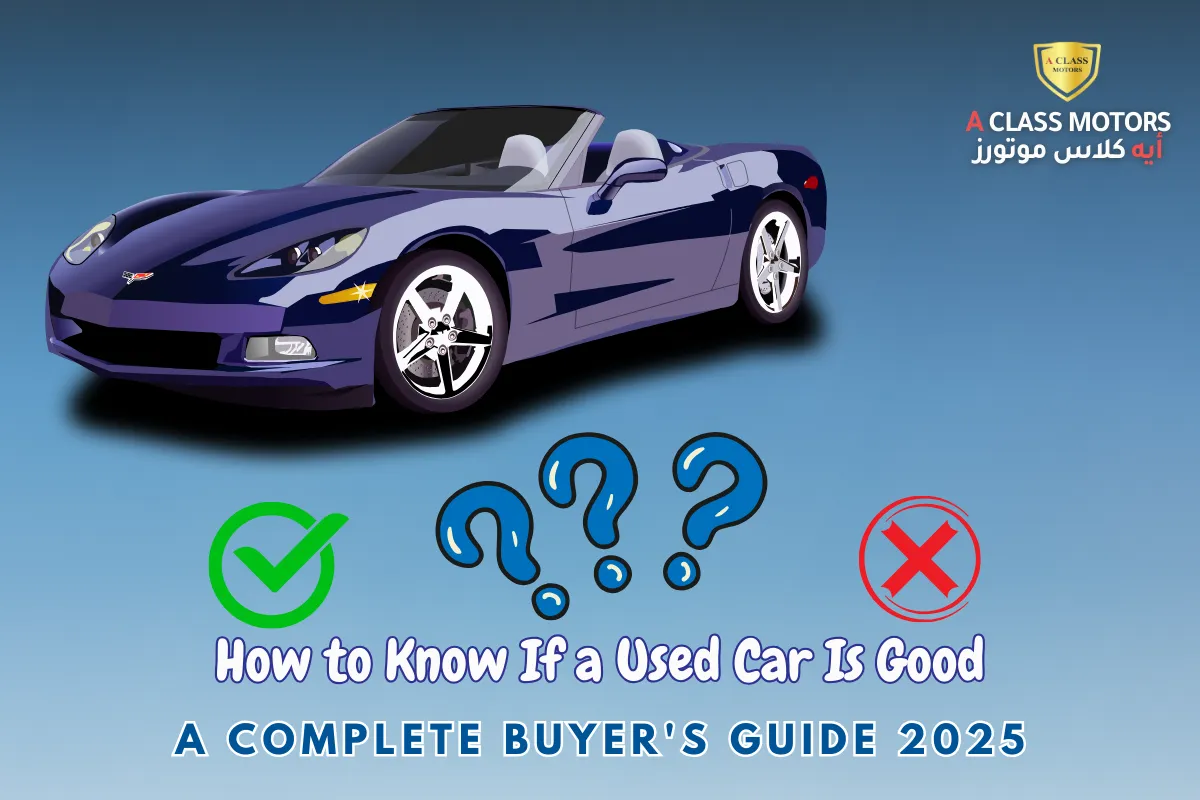Purchasing a used car can be a great way to save money, but how to know if a used car is good and not a potential headache? This guide will walk you through the essential checks and key considerations to help you make an informed decision.
From inspecting the car’s condition to understanding its history, we’ve got you covered with all the insights you need for a confident purchase.
Why Consider Buying a Used Car?
Opting for a used car is a smart way to save money without sacrificing reliability. Unlike new vehicles that rapidly depreciate, a well-maintained used car retains its value better, offering you more for your investment.
This means you could drive a higher-end model with premium features for the price of a basic new car. Additionally, the variety in the used car market allows you to find a vehicle that perfectly suits your needs and budget.
However, it’s essential to thoroughly inspect the car’s condition and review its history to avoid unexpected repair costs. With careful evaluation, buying used can be a cost-effective and rewarding choice.
Read Also : Used Cars in Dubai Under 10000 AED
Pros and Cons of Buying a Used Car
Pros:
- Lower Cost: Used cars are typically more affordable than new ones, allowing you to avoid the steep depreciation that happens in the first few years.
- Lower Insurance Premiums: Since insurance rates are often based on a car’s value, older vehicles usually come with cheaper premiums.
- Wider Selection: You can explore a range of models and years, giving you more flexibility to find a vehicle that fits your needs and budget.
Cons:
- Uncertain History: Unless you get a detailed vehicle history report, it’s challenging to know how the car was used or maintained by previous owners.
- Potentially Higher Maintenance Costs: Older cars are more likely to need repairs or part replacements, which can add up over time.
- Limited Warranty Coverage: Unlike new vehicles, used cars may have short or no warranty, leaving you responsible for any repair costs.
How to Know If a Used Car Is Good
To evaluate if a used car is a good purchase, start by examining its service history. A well-documented maintenance record shows that the vehicle has been properly cared for. Next, check the mileage—lower mileage generally means less wear and tear, but balance this with the car’s age.
Carefully inspect the car for signs of previous accidents, hidden damage, or rust, as these can lead to costly repairs down the line. Always take the car for a test drive to assess how it handles on the road and listen for unusual noises.
If possible, arrange a pre-purchase inspection with a trusted mechanic to identify any underlying mechanical issues. This step provides peace of mind and helps you make an informed buying decision.
Read Also: Used Exotic Cars for Sale Cheap
Essential Steps to Take Before Purchasing a Pre-Owned Vehicle
Before buying a pre-owned car, it’s important to make an informed decision to avoid future headaches. Here’s a detailed checklist to guide you through the process:
-
Set a Budget:
- Include not just the purchase price but also:
- Registration Fees – Costs vary depending on location and vehicle type.
- Insurance Premiums – Older cars may have lower premiums, but luxury models could be costly.
- Maintenance and Repairs – Consider future servicing, part replacements, and potential wear-and-tear.
- Include not just the purchase price but also:
-
Research Vehicle Models:
- Look for models known for reliability and affordable maintenance.
- Check for common issues or recalls associated with specific makes and years.
- Compare fuel efficiency, safety features, and resale value.
-
Check Online Listings:
- Browse multiple platforms to compare prices and features.
- Inspect photos for signs of damage or modifications.
- Contact sellers to ask detailed questions about the vehicle’s history and condition.
-
Run a Vehicle History Report:
- Verify the accident history to check for previous collisions.
- Look for any title issues, such as salvage or flood-damaged titles.
- Check for recalls and confirm if necessary repairs were completed.
Following these steps helps you make a well-informed purchase, ensuring the vehicle is safe, reliable, and worth the investment.
Critical Things to Inspect Before Buying a Used Car in the UAE
Buying a used car in the UAE requires careful inspection due to the harsh climate and unique driving conditions. Start by testing the air conditioning, as the extreme heat demands a highly efficient cooling system. Also, examine the exterior for any signs of rust or paint fading, which can occur faster under the intense sun.
Pay close attention to the tires for uneven wear, as it could indicate alignment issues or suspension problems caused by driving on rough or sandy terrain. Additionally, thoroughly check the chassis and undercarriage for damage or corrosion.
The UAE’s rugged road conditions can lead to structural issues that might not be visible at first glance. Taking these precautions ensures a reliable purchase and helps avoid costly repairs in the future.
Mistakes to Avoid When Shopping for a Second-Hand Car
-
Skipping the Test Drive – Always take the car for a spin before making a decision. A test drive helps you evaluate how the vehicle handles, listen for unusual noises, and identify any performance issues that might not be visible at first glance.
-
Overlooking the Paperwork – Make sure the seller provides all original documents, including the registration, insurance, and service history. This not only verifies the car’s authenticity but also protects you from potential legal complications.
-
Ignoring Dashboard Warning Lights – If any warning lights are on, don’t assume they’re minor issues. These alerts could point to expensive repairs, so it’s wise to have a professional inspection before committing to the purchase.
-
Focusing Solely on Price – A low price might seem tempting, but it could also indicate underlying problems. Consider the car’s condition, maintenance history, and overall value rather than just the cost.
Read Also: the most reliable luxury car brand in 2024
How to Assess the Mileage and Its Impact on Car Value
When evaluating a car’s value, mileage plays a crucial role in determining its longevity and potential future costs. High-mileage vehicles, typically over 200,000 km, may face increased repair needs, signaling a higher likelihood of wear and tear.
On the other hand, cars with very low mileage might have been sitting idle for extended periods, causing issues like dried-out seals or rust. The sweet spot often lies in the 80,000-150,000 km range, where the car has been used regularly but hasn’t undergone excessive strain.
These vehicles typically offer a great balance, offering enough life left while remaining relatively affordable. Regular maintenance history is key to ensuring that moderate mileage doesn’t compromise reliability or performance.
Key Features and Specifications to Consider in a Used Car
When shopping for a used car, prioritize features that enhance both safety and convenience:
- Fuel Efficiency: A car with great fuel economy helps you save on long-term expenses, reducing trips to the pump and supporting your budget.
- Advanced Safety Features: Essential components like Anti-lock Braking Systems (ABS), airbags, and traction control ensure a safer driving experience, especially in emergencies.
- Infotainment and Tech: Modern touches like Bluetooth connectivity, GPS navigation, and backup cameras can significantly enhance your driving experience, providing both entertainment and ease of use.
These features not only boost the car’s value but also contribute to a more enjoyable, secure ride.
Ways to Check If a Car Has Been in an Accident
Accident history can significantly affect a car’s performance, safety, and market value. Here’s how to spot potential signs:
- Uneven Paint or Misaligned Panels: These can indicate previous bodywork, often from collision repairs.
- Gaps Between Doors or Hood: Noticeable gaps may be a sign of structural damage, potentially linked to a past accident.
- Inconsistent Tire Wear: If the tires show uneven wear, it could suggest alignment issues caused by prior accidents, affecting the vehicle’s handling.
By keeping an eye out for these subtle yet telling clues, you can make a more informed decision when buying a used car.
Why Service History Matters When Buying a Used Vehicle
When purchasing a used vehicle, a comprehensive service history is a vital indicator of how well the car has been maintained over time. Regular oil changes, brake replacements, and any significant repairs should be documented.
These records demonstrate that the car has been cared for properly, minimizing the risk of hidden issues. A lack of service history raises red flags. It may suggest that the vehicle hasn’t received the attention it needs, which could result in costly repairs down the line.
Always ask for maintenance records to ensure that the car is in good condition and ready for years of driving ahead.
How to Find Out If a Car Has Any Open Recalls
When purchasing a used car, the service history is a crucial factor to consider. A complete record of maintenance shows the vehicle has been properly cared for, including routine tasks like oil changes, brake replacements, and major repairs.
Without a service history, there’s a risk that the car may have missed essential maintenance, leading to unexpected issues down the road. Additionally, it’s important to verify whether the car has any outstanding recalls. Recalls are often related to safety concerns, and unresolved ones can put you at risk.
You can easily check a car’s recall status through official government or dealership websites. Make sure all necessary repairs have been addressed before finalizing your purchase to ensure both the safety and longevity of the vehicle.
Understanding the Window Sticker: What It Reveals About the Car
Decoding the Window Sticker: Insights into a Used Car
The window sticker of a used car is more than just a label—it’s a detailed snapshot of the vehicle’s key features and specifications. It offers a deeper understanding of the car’s value and performance over time.
Key details include:
- Original MSRP: This shows the car’s original price, offering insight into how much the vehicle has depreciated since purchase.
- Fuel Economy Ratings: These numbers give you a clear picture of the car’s fuel efficiency, helping you estimate long-term costs.
- Standard vs. Optional Features: This breakdown allows you to compare the car’s features with others on the market, highlighting what’s included and what’s extra.
By carefully examining these points, you’ll have a clearer idea of the car’s worth and suitability for your needs.
Inspecting a Car’s Exterior and Interior for Hidden Issues
A comprehensive visual check is key to uncovering any hidden problems with a car.
Exterior:
- Examine the body for dents, scratches, or signs of rust.
- Check for paint chipping or inconsistencies, which might signal past repairs.
Interior:
- Inspect the seats for any visible wear or damage.
- Assess the dashboard and carpets for signs of heavy use or discoloration.
- Test all electronics, from power windows to lighting, to ensure they work properly and without issues.
By carefully inspecting these areas, you can avoid costly surprises and get a true sense of the car’s condition.
How to Tell If a Used Car Engine Is in Good Condition
When evaluating the condition of a used car engine, it’s crucial to approach the inspection methodically, as the engine is the heart of any vehicle.
Start by paying attention to any unusual sounds while the engine is running. Knocking or rattling noises can point to potential internal damage, so it’s important not to ignore them.
Next, check under the hood for any visible leaks. Leaking oil, coolant, or transmission fluid could indicate a serious issue with seals or gaskets.
Finally, keep an eye on the exhaust. If you notice blue or black smoke, it may be a sign of burning oil or other engine troubles that need immediate attention.
Tips for inspecting a used car engine:
- Listen closely for irregular noises like knocking or rattling.
- Check for fluid leaks around the engine and under the vehicle.
- Inspect the exhaust for any unusual smoke colors.
- Look for signs of excessive wear, like corroded or worn-out parts.
- Ask for a maintenance history to understand the engine’s background.
Checking a Vehicle’s Safety Ratings and Features Before Buying
When considering a vehicle, safety should always come first. Before making a purchase, it’s essential to check crash test ratings from reliable sources such as the IIHS (Insurance Institute for Highway Safety) or NHTSA (National Highway Traffic Safety Administration). These ratings give valuable insight into a car’s ability to protect its occupants in various accident scenarios.
Additionally, ensure the vehicle comes equipped with key safety features. Look for:
- Airbags: To protect both the driver and passengers in case of impact.
- Electronic Stability Control (ESC): Helps maintain control during slippery conditions or sharp turns.
- Antilock Brakes (ABS): Prevents the wheels from locking up during braking, enhancing steering control.
By paying attention to these factors, you can make an informed decision and feel confident in the safety of your new vehicle.
Steps to Take After Purchasing a Used Car
Once you’ve purchased a used car, it’s important to follow a few essential steps to ensure you’re set up for smooth driving. Here’s a guide to help you get started:
-
Complete Ownership Transfer and Update Insurance
Make sure the car’s title is transferred to your name, and update your insurance policy to reflect the new vehicle. This ensures you’re legally covered and compliant with local regulations. -
Schedule a Comprehensive Inspection
Even if the car looks great, a professional inspection is essential. A mechanic will check for hidden issues, from engine health to brake conditions, and offer advice on upcoming maintenance. -
Give Your Car a Fresh Start with Detailing
A thorough detailing is key to restoring the car’s appeal. Have both the interior and exterior cleaned, disinfected, and protected. This adds to your car’s longevity and provides a fresh, comfortable driving experience.
How to Evaluate the Overall Health of a Pre-Owned Car
When evaluating the health of a pre-owned car, several key factors come into play. First, examine the maintenance history—has the car been regularly serviced, and are there records to prove it? This is vital for understanding how well the car has been cared for.
Next, the engine’s condition is crucial. Check for any signs of wear, leaks, or irregularities in performance. A well-maintained engine typically signals a longer lifespan.
Also, pay attention to the car’s mileage—lower mileage often translates to less wear and tear, but don’t overlook a higher-mileage car if it’s been properly maintained.
Lastly, consider the car’s accident history. A vehicle with prior accidents may have hidden damage, so it’s essential to obtain a detailed report.
By carefully assessing these elements, you can make a more informed and confident decision when purchasing a pre-owned vehicle.
Finding a Trustworthy Mechanic for a Pre-Purchase Inspection
When buying a used car, a trustworthy mechanic is invaluable in spotting potential issues that may not be immediately obvious. Their expertise can save you from costly surprises down the road.
Look for a mechanic who specializes in the specific brand or model you’re interested in. Their experience with the vehicle type ensures they’ll know what to check for.
Before sealing the deal, request a comprehensive diagnostic report. This detailed assessment will give you insights into the car’s condition, highlighting any existing or upcoming problems. It’s an essential step in making an informed, confident purchase.
Best Used Cars Showroom in Dubai – A Class Motors
Looking for a reliable place to buy a high-quality used car in Dubai? A Class Motors is your go-to Second Hand Luxury Cars in Dubai ! Located at Used Cars Automarket, Al Aweer, Dubai, we offer a wide selection of top-condition pre-owned vehicles at competitive prices. Whether you’re searching for a luxury car, SUV, or budget-friendly sedan, we ensure transparency, quality, and excellent customer service.
Why Choose A Class Motors?
- Extensive Inventory: A variety of well-maintained used cars to suit every budget.
- Trusted Reputation: A proven track record of customer satisfaction in Dubai.
- Full Inspection Guarantee: Every car undergoes a thorough check before sale.
- Competitive Prices & Financing Options: Affordable deals with flexible payment plans.
Visit us today at Used Cars Automarket, Al Aweer, Dubai! Call us or send WhatsApp msg to Let us help you find the perfect used car with confidence!
FAQs
How do I verify a car’s history?
Check the VIN through a vehicle history report service or government databases.
Is it better to buy from a dealer or a private seller?
Dealers offer certified used cars with warranties, but private sellers often have lower prices.
What is a red flag when buying a used car?
Flood damage, inconsistent maintenance records, and major accident history.
How can I check if the car has outstanding loans?
Verify through the RTA or a finance check service.
What’s the ideal mileage for a used car?
80,000-150,000 km is generally considered reasonable.
How much should I negotiate off the asking price?
Start by offering 10-15% less than the listed price and negotiate based on the car’s condition.
Can I return a used car after buying it?
Most sales are final, but some dealers offer return policies—always check beforehand.
How do I test drive a used car?
Drive in different conditions, check the brakes, and listen for unusual noises.
Are extended warranties worth it?
If the car is out of its original warranty, an extended warranty can provide extra protection.













